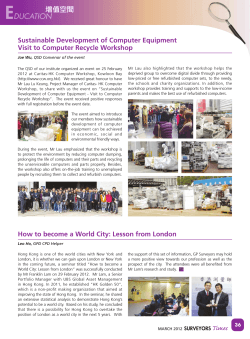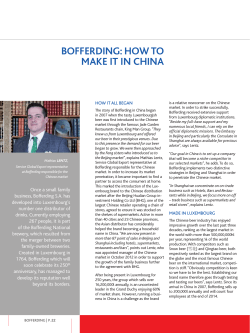
Why China Needs to Build Shanghai into an International Financial Centre?
Shanghai into an International Financial Centre? International JournalBuilding of China Studies Vol. 1, No. 1, January 2010, pp. 125-140 125 Why China Needs to Build Shanghai into an International Financial Centre? Yang Mu and Lim Tin Seng National University of Singapore Abstract After China adopted the open-door policy in 1978, Shanghai began to embark on a revival process to become China’s economic and financial hub. The directive to turn Shanghai into an international financial centre is timely as it came at a time when China is assuming a leading role in the global economic landscape. China is becoming bolder in the internationalization of its currency and is actively exploring means to reduce its dependency on the US dollar. It is a strategic move by the Chinese Government to identify Shanghai as China’s financial centre in order to prepare the country for the post-financial crisis era. However, Shanghai has to overcome a number of challenges. The first, in China today the government still plays important role in the economy. Most of the headquarters of China’s national and foreign banks as well as MNCs and local enterprises all prefer to be located in Beijing so that they can be nearer to the policymakers and regulatory commissions. Therefore, further financial reform and reduction of government intervention are the most important conditions for Shanghai’s international financial centre status. The second challenge is: Shanghai has to find a way to accommodate the ambition of other Chinese cities in becoming financial centres, such as Tianjin, Shenzhen, Guangzhou, Chongqing, Dalian and others. The third challenge is: Shanghai still has a lot to do in order shore up its current financial infrastructure. The most important step is to allow the convertibility of the yuan and allow the Chinese currency to be traded on the foreign exchange. China can relax the existing regulatory financial Dr Yang Mu 杨沐, Senior Research Fellow and Coordinator, China Cooperation Program, East Asian Institute, National University of Singapore. Email: eaiym@nus. edu.sg Lim Tin Seng 林鼎森, Research Officer, East Asian Institute, National University of Singapore. Email: eailts@nus.edu.sg IJCS vol 1 no 1.indb 125 4/16/2010 9:53:06 PM 126 Yang Mu and Lim Tin Seng mechanisms and allow more foreign companies to be listed in the QFII and local investors and enterprises in the QDII. China should also establish more financial products for investors. Authorities from the central government should also work with Shanghai officials in areas such as improving the efficiency and transparency of the city’s legal and accounting system in the financial sector as well as introducing incentives to attract financial talents to Shanghai. Hong Kong is able to provide invaluable lessons for Shanghai to develop its financial sector especially in areas such as liberalizing its capital market and improving its legal system. While these may indicate that Shanghai and Hong Kong could compliment each other, it could change in the coming years especially after China’s efforts to liberalize its financial sector and improve its financial governance gather steam. Keywords: international financial centre; US dollar trap; financial reform; convertibility 1. Introduction When Deng Xiaoping made his famous Southern Tour in 1991 he pointed out to Shanghai officials that Shanghai had been an important international financial centre before and could regain its financial status again in the future. After eighteen years in March 2009, China’s State Council announced an ambitious plan of turning Shanghai into a major international financial centre, on par with Hong Kong, Singapore, New York and London, by 2020. The State Council’s announcement is significant as it marked for the first time a concrete national-level backing and recognition of the city’s status as a financial hub. Prior to then, Shanghai was only functioning as China’s de facto financial hub and has recently been jostling this position with Beijing. The questions we need to discuss in this paper are: What is the specific target for Shanghai as China’s international financial centre from the Chinese government’s point of view? What has been achieved in Shanghai? Why does the Chinese government make this announcement now? Could Shanghai get this target? What are the main challenges? 2. What is the Target for Shanghai as an International Financial Centre? There have been many cities in East Asia that serve as the International Financial Centres such as Hong Kong, Singapore, Tokyo, Seoul, and others. They do not just compete with each other, but also compete with many IJCS vol 1 no 1.indb 126 4/16/2010 9:53:06 PM Building Shanghai into an International Financial Centre? 127 financial centres outside the region such as New York and London, and inside the region such as Shanghai and others. Since 1978 Hong Kong has served China as an International Financial Centre. Many foreign investments went into China via Hong Kong. Many of China’s large SOEs have been listed in the HK stock market or financed from the HK bond market or money market. Owing to China’s fast growing in 2009 HK Stock Exchange was No. 1 in the world for the raised capital through IPO. Then, the question for us is that why in 2009 the Chinese government needs to announce to build Shanghai as China’s International Financial Centre in 2020? As stated by Liu Tienan, Vice-Minister of the National Development and Reform Commission (NDRC), the reason why the State Council gave its official endorsement is simply because the city is the “most qualified metropolitan city on the Chinese mainland to pursue the ambition”. As shown in the guidelines accompanying the State Council’s decision, the process to build Shanghai into an international financial hub encompasses features such as advocating the use of yuan for international trade settlement, developing private equity and developing a re-insurance market, and encouraging overseas enterprises to issue yuan-denominated bonds in China (Table 1). Table 1 Key Measures to Support Shanghai’s Development as a Financial Hub Key Measures 1 Conduct trade settlement in yuan on trial basis 2 Fully tap the financial market in Shanghai in terms of clearing in yuan 3 Develop over-the-counter markets for non-listed companies in the Yangtze River Delta 4 Study a mechanism to help companies traded on the OTC markets to be transferred to the main stock boards 5 Develop pension products that offer tax breaks to encourage people to pay into pensions 6 Encourage more international development institutions to issue yuandenominated bonds 7 Study plans to allow overseas enterprises to issue yuan-denominated bonds in China 8 To allow qualified overseas companies to issue yuan-denominated shares 9 Step up development of the re-insurance market 10 Give priority in terms of business expansion to securities and fundmanagement joint ventures 11 Encourage financial institutions to cover a wider range of businesses 12 Encourage the development of private equity and venture capital companies Source: China Daily. IJCS vol 1 no 1.indb 127 4/16/2010 9:53:06 PM 128 Yang Mu and Lim Tin Seng From these measures and statements it is very clear that the most important target for Shanghai in 2020 is being the centre for the RMB transaction in the world for trade settlement and equity investment. Besides, the State Council also called for the city to step up efforts to shore up its soft infrastructure. These include introducing initiatives such as providing incentives and measures to attract and train financial talents. It also requires banks in China to provide sophisticated investment products, creating a more transparent and independent legal system and promulgating favourable tax policies to attract financial companies. These are basic conditions for all financial centres. 3. How Suitable is Shanghai as an International Financial Centre? Historically, Shanghai has always been a centre for trade and commerce especially after its establishment as a treaty port in the mid-19th century. By the 1920s and 1930s, the city has flourished to become one of the world’s major cities and an important entrepot. Consequently, this also led to the growth of Shanghai’s financial sector. However, the city’s progress as an economic and financial hub was interrupted and overshadowed by Hong Kong after 1949. After China adopted the open-door policy in 1978, Shanghai began to embark on a revival process to become China’s economic and financial hub. This process was consolidated and gathered speed after Deng Xiaoping initiated the Pudong New Area Project in his nanxun (southern tour) in 1992. Thereafter, Shanghai experienced a period of spectacular economic growth that lasted until the present. As Figure 1 shows, Shanghai’s GDP has been growing double-digit for most years since 1992. Shanghai’s revival also took place on a different course that is different from most Chinese cities. Instead of focusing on the growth of the manufacturing sector as seen in cities such as Shenzhen, Tianjin and Beijing, Shanghai’s economy was powered by the service sector. As seen in Figure 2, Shanghai’s service sector contributed to nearly 55 per cent of the city’s GDP in 2007. It also absorbed about 55 per cent of the city’s labour force in the same year. In this sense, it is no surprise that Shanghai has a relatively complete financial sector. In 2007, Shanghai’s financial industry generated an added value of about 144 billion yuan (US$21 billion). This is an increase of about 15 per cent from the previous year and about 10 per cent of Shanghai’s total GDP in 2007 (Figure 3). As at the end of 2008, there were a total of 689 financial institutions in the city. Of that, 124 were commercial banks, 291 were insurance companies and the remaining 94 were securities companies. Of the total, 165 were foreign banks (Lan, 2009). IJCS vol 1 no 1.indb 128 4/16/2010 9:53:06 PM Building Shanghai into an International Financial Centre? 129 Figure 1 Shanghai’s and China’s GDP Growth, 1978-2008 18 16 Shanghai's GDP Growth 14 Percent 12 10 8 6 China's GDP Growth 4 2008 2007 2006 2005 2004 2003 2002 2001 2000 1999 1998 1997 1996 1995 1994 1993 1992 1991 1990 1989 1988 1987 1986 1985 1984 1983 1982 1981 1980 1979 0 1978 2 Source:China Statistical Yearbook, various issues; Shanghai Statistical Yearbook, various issues. Figure 2 Components of Shanghai’s GDP, 1978-2007 90 80 Manufacturing 70 Percent 60 50 Services 40 30 20 Agriculture 2007 2006 2005 2004 2003 2002 2001 2000 1999 1998 1997 1996 1995 1994 1993 1992 1991 1990 1989 1988 1987 1986 1985 1984 1983 1982 1981 1980 1979 0 1978 10 Source:Shanghai Statistical Yearbook, various issues. IJCS vol 1 no 1.indb 129 4/16/2010 9:53:06 PM 130 Yang Mu and Lim Tin Seng Figure 3 Percentage Share of Financial Sector in Shanghai’s Total GDP and Service Sector, 1978-2007 35 31.6 29.5 30 24.6 24.5 22.7 Service Sector 18.9 10.8 9.1 8.9 9.2 11.8 11.9 10.2 9.8 9.9 9.3 7.6 7.4 8.0 2007 2003 2002 1999 1998 1997 1996 1995 1993 1992 1991 1988 9.3 15.7 GDP 1990 6.5 1989 6.2 1987 5.2 1986 1981 1985 1980 4.4 1984 1979 4.4 1983 2.6 4.3 1982 2.5 1978 0 2.6 4.0 9.1 14.9 14.6 12.6 2005 11.9 11.9 10 2.6 18.9 18.4 2004 13.4 13.5 13.8 15 13.8 13.8 5 19.2 16.9 2001 18.0 18.3 17.5 24.3 24.1 2000 20 27.6 27.1 22.3 1994 Percent 21.3 26.9 2006 25 28.9 27.5 26.9 Source:Shanghai Statistical Yearbook, various issues. Shanghai is also home to the Shanghai stock exchange (SSE). As at the end of 2008, the SSE had 864 listed companies with a combined capitalization of RMB$9.7 trillion and raised capital of RMB223.8 billion. This made the Chinese benchmark the world’s sixth largest stock index in terms of market capitalization and capital raised. The trade volume amounted to RMB18.0 trillion and ranked the No. 7 in the world and the No. 2 in Asia. Since it was set up in 1990, trading within the SSE has gradually been liberalized to allow the inflow of foreign funds and yuan-denominated trading. For instance, the SSE introduced the Qualified Foreign Institution Investor (QFII) programme in 2003 and the Qualified Domestic Institutional Investor (QDII) programme in 2006.1 The QFII allowed foreign investors to buy yuandenominated shares in the SSE, while the QDII allowed domestic financial institutions to invest in shares in offshore markets. These measures are seen as milestones as China’s capital market has always been heavily regulated by the central government since it adopted the open-door policy. Presently, 30 fund management companies are located in Shanghai and manage RMB721 billion assets, 37.1 per cent of the total in China. Six insurance assets management companies are located in Shanghai and manage about RMB1 trillion assets, 46 per cent of the total in China. Other kinds of securities investment funds, QFII, QDII and private bankings are mainly concentrated in Shanghai as well. By the end of 2008, Shanghai has 10 private IJCS vol 1 no 1.indb 130 4/16/2010 9:53:07 PM Building Shanghai into an International Financial Centre? 131 banking institutions. Due to the rapid accumulation of Chinese wealth and the continuously increasing enthusiasm of international capital into China, capital assets management business will continue to grow rapidly. In addition to the stock exchange, Shanghai has also introduced a number of financial institutions since 1990. These include bond market, money market, exchange market, commodity future market, financial future market, gold market, property exchange market and OTC derivatives market (see Table 2). In 2008 the trading volume of caoutchouc future amounted to RMB9.3 trillion in Shanghai Future Exchange, ranked No.1 in the world. The trading volume of copper futures amounted to RMB9.9 trillion, No. 2 in the world. Table 2 Financial Institutions in Shanghai since 1990 Institutions Content Founding Status or Scale Year Shanghai Securities Main, capital market 1990 Exchange (equity, bonds) 80 per cent of total trading turnover in China Foreign exchange Foreign exchange 1994 trading centre Head office of national trading market Inter-bank loan Money market 1996 centre National centre for interbank trading RMB bond trading Money market 1997 centre National centre for bond trading Shanghai Futures Exchange 60 per cent of futures trading volume of all China Rubber, copper, 1999 aluminium and fuel oil Shanghai Gold Gold market 2002 Exchange The only gold market Note market service centre Principal note pricing system in China Provide note trans- 2003 action information and service Shanghai Petroleum Futures transactions 2006 market The only petroleum market in China China Financial Futures Exchange The only derivative market in China Financial derivative 2006 transactions Source: Young et al. (eds) (2009: 234). IJCS vol 1 no 1.indb 131 4/16/2010 9:53:07 PM 132 Yang Mu and Lim Tin Seng And the trading volume of spot gold amounted to RMB869.6 billion in Shanghai Gold Exchange and also ranked No. 1 in the world. However, in order to prepare Shanghai’s progress into an international financial hub, the central government needs to do more to further liberalize China’s capital market. Indeed, in June 2009, Beijing approved foreign companies to be listed in the SSE.2 This is an unprecedented move and a huge step forward in liberalizing China’s capital market as the policy will not only set the stage for the inflow of more foreign funds, but also allow foreign companies to raise capital in China. 4. Rationale of Turning Shanghai into an International Financial Centre The directive to turn Shanghai into an international financial centre is timely as it came at a time when China is assuming a leading role in the global economic landscape. Indeed, China is set to replace Japan as the second largest economy in the world in the coming months. It is also the world’s largest manufacturing base, the largest exporter, and also the biggest commodity importer. Besides, China holds 40 per cent (or around US$2.4 trillion) of the world’s foreign exchange reserves and is also the world’s largest holder of US treasury bills. In addition, three of China’s Big Four Banks have become the leading world banks in terms of market capitalization (see Appendix Table 1). More importantly, China is becoming bolder in the internationalization of its currency and is actively exploring means to reduce its dependency on the US dollar. As the world is beginning to witness, the emergency actions taken by the global economies, particularly the United States, to free credit markets and boost demands are likely to bring a second round of inflation.3 In fact, signs of inflationary pressure could be seen with the recent spike of oil prices from about US$40 per barrel in March 2009 to over US$80 per barrel by the end of 2009 as well as the 30 per cent increase of raw material prices and the surge of gold futures to over US$1,100 during the same period. The imminent arrival of a second round of inflation is no good news for the US dollar. Signs of a weakening dollar can already be seen with yields of the ten-year Treasury bill jumping from around two per cent at the end of 2008 to almost four per cent by early June 2009.4 Besides, exchange rates of the Euro as well as other international currencies have also strengthened considerably against the US dollar in 2009. As the global economy shows signs of life, there will be even more downward pressure on the US dollar as investors become less risk averse and do not need the dollar’s security. With this developing trend, there is now a possibility that China would be plunged into the “US dollar trap”. Coined by Nobel laureate Paul Krugman in IJCS vol 1 no 1.indb 132 4/16/2010 9:53:07 PM Building Shanghai into an International Financial Centre? 133 his New York Times article, this concept is used to explain the massive value loss that China would face on its huge foreign reserve due to a depreciated US dollar (Krugman, 2009). Beijing is aware of this developing trend and has come out with a number of ways to address it. For instance, in March 2009, Zhou Xiaochuan, governor of the People’s Bank of China, called for the establishment of a super-sovereign reserve currency based on the existing special drawing rights to replace the US dollar (Yang and Chen, 2009). Furthermore, since December 2008, Beijing has concluded a series of swap currency agreements with its trading partners and experimented with the idea of conducting trade and investment activities using yuan and the respective partners’ currency. To date, the People’s Bank of China has arranged six bilateral currency swaps, totalling more than 650 billion yuan (US$95 billion), with countries including Japan, South Korea, Malaysia, Hong Kong, Brazil and Argentina.5 The swap currency could be used for trade settlements between China and its trading partners. As a start, Shanghai, Shenzhen, Zhuhai, Dongguang and Nanning were chosen by the Chinese government to use RMB for trade settlements. The first swap currency agreement between China and Hong Kong which involved more than 440 companies would take effect in June 2009.6 The Chinese government is also planning to include the purchase of RMB financial products in the currency swap agreements. However, establishing these non-US dollar denominated platforms would not be possible if the Chinese yuan remains nonconvertible and foreign capital flows are still heavily restricted. Furthermore, there will be even more shortcomings if there isn’t any base for foreign traders or investors to get a foothold on China’s financial market. Therefore, it is a strategic move by the State Council to identify Shanghai as China’s financial centre in order to prepare the country for the post-financial crisis era. 5. Challenges Ahead In order to fully become an international financial centre within the stipulated timeframe, Shanghai has to overcome a number of challenges. The first and the most important challenge is despite being designated as China’s official financial centre, Shanghai still needs to wrest this position from competing with Beijing. In fact, Beijing’s financial prowess is comparable to Shanghai. In 2007, Beijing’s financial sector was worth 112.7 billion yuan (US$16.1 billion), making up about 12.5 per cent of the city’s GDP. Shanghai’s financial sector, on the other hand, was worth around 119.6 billion yuan (US$17.1 billion) or about 10 per cent of its GDP in the same year.7 In addition, Beijing is home to 677 financial institutions compared to Shanghai’s 604 and most of IJCS vol 1 no 1.indb 133 4/16/2010 9:53:07 PM 134 Yang Mu and Lim Tin Seng the headquarters of China’s national and foreign banks are located in Beijing instead of Shanghai. Largely, this is because in China today the government still plays an important role in the economy. For instance, government investment is the most important driving force for China’s economy, the main source of bank deposit and the largest loan issuer. In addition, IPOs and the reissuing of shares are controlled by the China Securities Regulatory Commission in Beijing. As a result, most of the headquarters of China’s national and foreign banks as well as MNCs and local enterprises all prefer to be located in Beijing so that they can be nearer to the policymakers and regulatory commissions. In fact, the market mechanism in financial resource allocation is the most important thing for a city with a comparative advantage to become an international financial centre. So, the further financial reform and reduction of the government intervention are the most important conditions for Shanghai’s international financial centre’s status. It is not an easy task, obviously, and could not be controlled by the Shanghai government. However, compared with Shanghai, Beijing does not have an institutionalized stock market, money market, currency market and future market. Its financial infrastructure is less established. For instance, it does not have a stock exchange or gold and futures exchanges. This gives Shanghai the edge to function as China’s main financial centre. The second challenge is Shanghai has to find a way to accommodate the ambition of other Chinese cities in becoming financial centres. In the years ahead, Shanghai is bound to face more competition from other Chinese cities as they try to build up their service sector. In fact, Tianjin, Shenzhen, Guangzhou, Chongqing, Dalian have recently announced that they will be adopting this development strategy. To accommodate this development trend, Shanghai can start by working with these cities to create a win-win situation. One suggestion is to have Shanghai to position itself as the main financial centre in China and the competing cities to be regional financial centres. For instance, Beijing and Tianjin can provide financial support to the northern areas while Shenzhen can be the financial centre of the Pearl River Delta region. The third challenge is Shanghai still has a lot to do in order shore up its current financial infrastructure. Although Shanghai has a better financial platform compared to its city rivals in China, it is still not up to international standards. According to the latest Global Financial Centres Index (GFCI) which ranks the competitiveness of financial centres across the globe, Shanghai is positioned at 35 out of the total of 62 centres in 2008, one place worse than the previous year (Table 3). On the other hand, the financial cities that Shanghai wants to emulate, namely London, New York, Hong Kong and Singapore, are among the top five. IJCS vol 1 no 1.indb 134 4/16/2010 9:53:07 PM Building Shanghai into an International Financial Centre? 135 Table 3 The Global Financial Centres Index 2007 and 2008 Ranking Financial Centre GFCI 2007 Ranking GFCI 2008 Ranking London New York Singapore Hong Kong Zurich Geneva Chicago Frankfurt Boston Dublin 1 2 3 4 5 6 9 8 7 13 1 2 3 4 5 6 7 8 9 10 Shanghai 34 35 Beijing 47 5 Budapest 59 62 Source: The Global Financial Centres Index 5. The reason why Shanghai faired that badly is simply because the city could not offer the business environment that makes it accessible and competitive. To a large extent, this is due to high level of restrictions in the city’s financial sector. This includes the strict capital control and regulatory environment as well as the ineffective taxation policies on companies. In addition, Shanghai is also lacking in terms of having an efficient legal and accounting system and in attracting and retaining financial services professionals (Yeandle et al., 2009: 22-23). To deal with this problem, China can start by stepping up efforts to liberalize the nation’s capital market. Among the most important steps is to allow the convertibility of the yuan and allow the Chinese currency to be traded on the foreign exchange. This would not be easy as government interventions and initiatives take precedent over market mechanisms in China. Nonetheless, China’s policymakers have to overcome this tradition in order to successfully turn Shanghai into an international financial centre. Another step that China can take is to relax the existing regulatory financial mechanisms such as the QFII and QDII programmes. China’s administrators could first increase the investment quota and allow more foreign companies to be listed in the QFII and local investors and enterprises in the QDII. This would improve the platform for both foreign and local investors to invest directly in both overseas and domestic markets. IJCS vol 1 no 1.indb 135 4/16/2010 9:53:07 PM 136 Yang Mu and Lim Tin Seng In addition, China should also establish more financial products for investors. Some of these include future markets and markets for bonds, derivatives and currency trade. Besides, authorities from the central government should also work with Shanghai officials in areas such as improving the efficiency and transparency of the city’s legal and accounting system in the financial sector as well as introducing incentives to attract financial talents to Shanghai. While it is important for Shanghai to develop its financial platform by expanding its modern financial services and products such as offering banking, international settlement, financing for merger and acquisition, insurance and asset management services and other sophisticated investment products, the city should also preserve some of the more traditional financial services. This includes providing services and incentives to help foreign and local companies to set up a regional headquarter in Shanghai where they can manage their production network in the area. So far, Shanghai seems to be heading down this path by introducing measures such as allowing locally incorporated foreign banks to issue yuandenominated bonds or to allow China-based foreign companies to be listed in the Shanghai stock exchange. There are also talks on the possibility for the State Administration of Foreign Exchange (SAFE) to increase to investment quota of the QFII programme so that more foreign funds could enter the Chinese financial market. While these are encouraging development, there is still a lot to be done. In fact, Chinese authorities should start considering abolishing these control measures completely at the national level so that funds can flow in and out of the financial market freely. 6. Hong Kong’s Role in Shanghai’s Ambition The State Council’s announcement to turn Shanghai into an international financial centre by 2020 has raised concerns in Hong Kong. According to reports, Hong Kong is worried that Shanghai’s ambition would undermine the city’s position as an international financial centre. To allay such fear, Shanghai’s Party Secretary Yu Zhengsheng assured Hong Kongers that Shanghai is still lagging behind Hong Kong as a financial centre in many aspects.8 Furthermore, it is also likely that Shanghai will continue to function as a regional financial centre as the city continues to develop and liberalize its financial sector in the coming years. As one of the world’s leading financial centre, Hong Kong is also able to provide invaluable lessons for Shanghai to develop its financial sector especially in areas such as liberalizing its capital market and improving its legal system. In addition, Hong Kong could also help Shanghai to improve the latter’s corporate and commercial infrastructure (see Appendix Table 2 IJCS vol 1 no 1.indb 136 4/16/2010 9:53:07 PM Building Shanghai into an International Financial Centre? 137 for SWOT analysis of Hong Kong and Shanghai as international financial centre). While these may indicate that Shanghai and Hong Kong could compliment each other, but it could change in the coming years especially after China’s efforts to liberalize its financial sector and improve its financial governance gather steam. In addition, unlike Hong Kong, Shanghai has the added advantage of having a strong manufacturing base located in its own backyard: the Yangtze River Delta. Furthermore, Shanghai’s manufacturing sector also has a high level of technology innovation capability, giving the city an advantage to attract value-added companies. The Chinese city also has a well-developed transportation and logistic sector. With a favourable financial environment, these could make Shanghai more suitable than Hong Kong to serve as a platform for companies to set up their headquarters to manage their production in the area. In fact, Premier Wen Jiabao warned Hong Kong to “raise its game or face decline” in the same month after the State Council’s announced the directive to turn Shanghai into a financial centre.9 The news was chilling for Hong Kong especially its economy was badly hit by the current global financial crisis. Nonetheless, Hong Kong could overcome Shanghai’s challenge and turn it into a “win-win” situation by revising its traditional role as the gateway to China for investors. Some of the new roles that it could adopt may include providing consulting services to Chinese businesses seeking to expand overseas or as an education hub to train Mainland Chinese to become qualified financial and business professionals. This process is not something new as the city has adapted before as it went from selling plastic flowers to higher levels of manufacturing before reaching the present state of being a global financial capital. 7. Conclusion International financial centres are the places where all sorts of international financial services and legal services such as underwriting, trading, dealing and brokerage of services are produced, sold and exported. Shanghai with almost all kinds of financial markets established in the last twenty years has obvious potential to be built as China’s international financial centre. However, there are two most important conditions: further financial reform (Shanghai really becomes the No. 1 financial centre in China, but not Beijing) and the full convertibility of RMB are totally dependent on Beijing’s leaders, but not market. There is no doubt that China’s economy is going to exceed Japan’s and US’s, and RMB will be internationalized, and Shanghai will be China’s international financial centre, eventually. But, could it be completed in the next ten years? We need to watch it carefully. IJCS vol 1 no 1.indb 137 4/16/2010 9:53:07 PM IJCS vol 1 no 1.indb 138 1 2 3 4 5 6 7 8 9 10 Citigroup HSBC Bank of America Wells Fargo RBS UBS JP Morgan Chase Mitsubishi Tokyo Wachovia Bank One 2004 Ranking Source: Young et al. (eds) (2009: xlvii). Banks Ranking 259 163 118 97 89 86 85 63 61 60 2008 Ranking Industrial & Commercial Bank of China China Construction Bank Bank of China HSBC JP Morgan Chase Wells Fargo Banco Santander Bank of America Mitsubishi UFJ Financial BNP Paribas Market Value Banks (US$ billion) Top 10 Biggest Banks in 2004 and 2009 Appendix Table 1 252 180 151 140 125 110 95 85 75 74 Market Value (US$ billion) 138 Yang Mu and Lim Tin Seng 4/16/2010 9:53:07 PM Building Shanghai into an International Financial Centre? 139 Appendix Table 2 Swot Analysis of Hong Kong and Shanghai as International Financial Centre HONG KONG SHANGHAI Strengths Strengths ● High level of transparency of the ● government and its policies ● Political and social stability ● ● Equitable treatment of foreigners ● ● Foreign exchange stability and ● abundant liquidity ● Superb financial infrastructure ● Minimal interference by financial supervisory/regulatory authority ● Predictable legal environment ● Workforce with good financial expertise and international experiences ● English-speaking population ● Regional headquarters for many global financial institutions, including investment banks Weaknesses ● Limited local market size ● ● Serious air pollution ● ● ● ● Opportunities Very large economic power and abundant human resources Large domestic capital market Very good potential for continuation of high growth Possess a large amount of domestic savings Weaknesses Regulations hindering efficient functioning of the market mechanism Limited openness to foreign investment Slow internationalization of the capital markets Soft financial infrastructure development lagging behind hard infrastructure development Limited command of the English language among the local population Opportunities ● Physical proximity with China ● Opening of the market to foreign firms and investors ● The role of a bridge connecting foreign companies to investors in China Threats Threats ● Competition with Shanghai as a ● Competition with Hong Kong to become financial centre the main financial centre in China Source: Young et al. (eds) (2009: 7, 15). IJCS vol 1 no 1.indb 139 4/16/2010 9:53:07 PM 140 Yang Mu and Lim Tin Seng Notes 1. See Lu and Li (2007: 282-283) for more details on reforms carried out in the Shanghai Stock Exchange. 2. “Shanghai Stock Market Opens to Foreign Firms”, Telegraph, 1st May 2009. 3. “The Biggest Bill in History”, The Economist, 13th June 2009. 4. “This Way Out”, The Economist, 6th June 2009. 5. “BIS-China, Brazil Working on Trade FX Deal-cenbanks”, Reuters, 28th June 2009. 6. The Straits Times, 3rd July 2009, Singapore; Xin Bao, 30th June 2009, Hong Kong. 7. “Beijing’s Financial Dream”, Beijing Review, 24th May 2008. 8. Xingdao Ribao, 19th June 2009. 9. “Shanghai Surprise: China backs its own global market”, Newsweek, 5th June 2009. References Krugman, Paul (2009), “China’s Dollar Trap”, The New York Times, 2nd April (accessed at http://www.nytimes.com/2009/04/03/opinion/03krugman.html, 1st June 2009). Lan Xinzhen, “Rebranding Shanghai”, Beijing Review, 14th May 2009. Lu Ding and Li Ning (2007), “China’s Capital Market Reform: Problems and Prospects”, in John Wong and Liu Wei (eds), China’s Surging Economy: Adjusting for More Balanced Development, Singapore: World Scientific, pp. 253-304. Yang Mu and Chen Shaofeng “Can China Reduce Foreign Reserve Risks?”, China Daily, 20th May 2009. Yeandle, Mark, Jeremy Horne, Nick Danev and Alexander Knapp of the Z/Yen Group (2009), The Global Financial Centres Index 5, City of London Corporation, March. Young, Soogil, Dosoung Choi et al. (eds) (2009), Competition among Financial Centres in Asia-Pacific: Prospects, Benefits, Risks and Policy Changes, Singapore: ISEAS. IJCS vol 1 no 1.indb 140 4/16/2010 9:53:07 PM
© Copyright 2025









